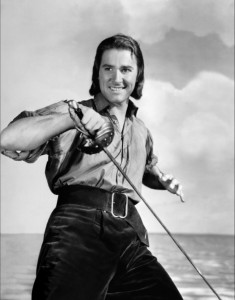
A well-done pirate movie is a sure way to cheer yourself up when you need it. No, I’m not thinking of those silly Johnny Depp films, but the more classic variety—and especially one in particular: Captain Blood, from Warner Brothers in 1935. Here’s the story: in 17th century England, a young doctor (played by Errol Flynn) is convicted of treason for treating a rebel’s wounds. Sold into slavery in the West Indies, he escapes with a group of his fellow slaves and becomes a notorious pirate.
By the time the veteran director Michael Curtiz was assigned to remake this Rafael Sabatini adventure (there had been a silent version in the 20s) the swashbuckler genre had lost some of the box office luster it had in the heyday of Douglas Fairbanks. When Robert Donat became ill, the director installed Errol Flynn, an unknown bit player, in the title role, against studio advice. Flynn had limited range as an actor, but he possessed an important element: tremendous charisma. The camera loves the handsome Aussie—whether he’s ordering his pirate crew to man the guns or courting Olivia de Havilland, he projects an infectious air of gallantry and exuberance. The film made him a star, along with De Havilland (who was barely nineteen at the time)—they would be paired together in movies seven more times, all but one of them under Curtiz.
For the villain we have Lionel Atwill as a ruthless slave master, the De Havilland character’s uncle. Basil Rathbone is on hand as a rival French pirate—and of course he has a sword fight with Flynn, which is one of the high points. Add a rousing score by Erich Korngold (who would go on to do the music for many other Warner Brothers adventures) and you have a bona fide classic.
Considered as history, the screenplay—purporting to depict the time of James II—is sheer nonsense, but no one, now or then, watches a pirate movie for historical accuracy. Captain Blood is just plain fun. It has everything: wrongful imprisonment, romance, daring escapes, battles at sea in which the pirates swing over to another ship to fight hand-to-hand. Essentially it’s a blueprint for every swashbuckler that was to follow. And although it’s not the very best Errol Flynn movie (most would agree that The Adventures of Robin Hood holds that distinction), it’s perhaps the one to start with if you want to understand his appeal. He never did attain much skill as an actor (alcohol played a part in that). In this movie, though, we can see the energy and freshness that gradually faded after he gained fame.
As a director, Michael Curtiz was one of the greatest workhorses in Hollywood. Here he created the illusion of sweeping spectacle on what was in fact a very tight budget. Watching Captain Blood is a reminder of a time when movies could offer escapism of the highest order with minimal special effects.






